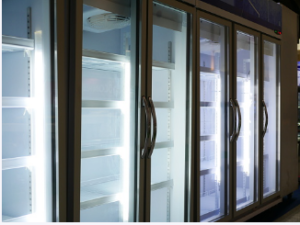Commercial refrigeration equipment is used by businesses, hospitals and restaurants to keep food and beverages cool by extracting heat to prevent spoilage and preserve freshness.
 Refrigerators use up a significant amount of energy when used frequently. Newer fridges have improved energy efficiency using refrigerants with zero ozone depletion and low global warming potential, such as propane (R-290) or carbon dioxide (R-744). These technologies can save businesses on their energy costs.
Refrigerators use up a significant amount of energy when used frequently. Newer fridges have improved energy efficiency using refrigerants with zero ozone depletion and low global warming potential, such as propane (R-290) or carbon dioxide (R-744). These technologies can save businesses on their energy costs.
Refrigeration System
Commercial refrigeration Adelaide near me systems comprise multiple components essential to keeping products cool and safe, working off of thermodynamic principles that dictate that heat moves from warmer objects to cooler ones. They utilise non-toxic and non-flammable refrigerants, which are heated by compressors before turning back into liquid form in the condenser before being directed through a metering device for regulation before entering an evaporator.
A metering device controls the amount of liquid entering an evaporator based on equipment size and refrigerant type used. This metering device connects directly to the suction line, hot gas line, liquid line and suction/hot gas lines via tubing connections – this ensures an identical mechanical cycle across domestic refrigerators, low-temperature freezers, comfort air conditioning systems and industrial chillers.
Refrigeration systems are integral to many businesses, from grocery stores and hospitals to food processing plants and restaurants. Their purpose is to preserve perishable items so they stay at peak quality and freshness, with features like accessible temperature controls and adjustable shelving making them easier for users. When looking for refrigeration units, look for ones from well-known brand names to ensure Energy Star compliance – this may save money on energy costs!
Compressor
The compressor is the heart of your refrigerator as it powers its refrigeration cycle by turning refrigerant from vapour into gas, then back into liquid form. Starting as cool, low-pressure vapour from the evaporator coils, it travels to the condenser, where it cools before returning as liquid again to repeat the cycle until food remains at an ideal temperature – hence that low hum you hear in the cooler is your compressor at work trying to maintain proper temperatures of air inside!
Commercial refrigeration Adelaide near me compressors come in various sizes to meet different capacities. Their nominal capacities depend on standard operating conditions like condensing and evaporative temperatures, lubrication, refrigerant usage, and motor revolutions per minute (rpm). Hermetic designs tend to be the largest compressors, while others may be open or semi-hermetic models.
Refrigeration compressors in commercial refrigeration environments use various coolants, from traditional freon to more modern refrigerants, with zero ozone depletion and lower global warming potential. Utilising the appropriate type of compressor and refrigerant can save money in energy bills, maintenance fees and repairs while decreasing waste by not having to discard food that wasn’t stored at its proper temperature.
Condenser
The condenser is responsible for discharging low-temperature heat that the evaporator has stored up into its surroundings. It blows air over condenser coils to cool the refrigerant down before returning it to the evaporator and starting the cycle.
A condenser unit should be installed in an environment with sufficient open space on all sides for air to enter its coil intake vents freely and on a firm, durable surface instead of soft ground where debris or dust may collect along its tubing, diminishing efficiency. Furthermore, proximity to the cold part of the cycle (evaporator) should help minimise pressure loss within the system.
Condensers come in all shapes and sizes to fit different applications, yet all have one thing in common – they all aim to help refrigerants shed heat as quickly as possible. It is accomplished using fins on their coil that are designed specifically to increase its surface area for heat rejection.
Condensers can be utilised with different refrigerants, though hermetic systems using R-134a or R-404A are the most frequently found in convenience stores and mini-supermarkets. New low GWP A2L refrigerants being developed as F-gases replacements could offer similar performance while providing environmental benefits.
Evaporator
Your expansion valve supplies liquid refrigerant to your evaporator coils, which expand into a vapour form and absorbs heat from air flowing over it. For maximum capacity, ensure sufficient liquid refrigerant flows throughout each coil to avoid starvation; otherwise, it might fail to expand and fully make your evaporator function as intended.
Once your evaporator has taken in all of its heat, it condenses back into a liquid state, but at a much lower temperature than what was picked up during its operation. It allows it to quickly circulate over your items inside your fridge and cool them quickly.